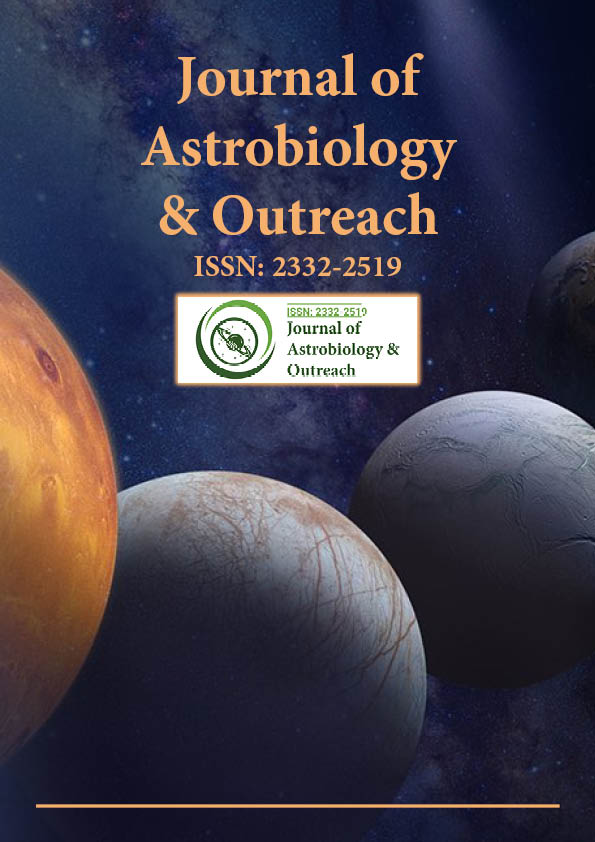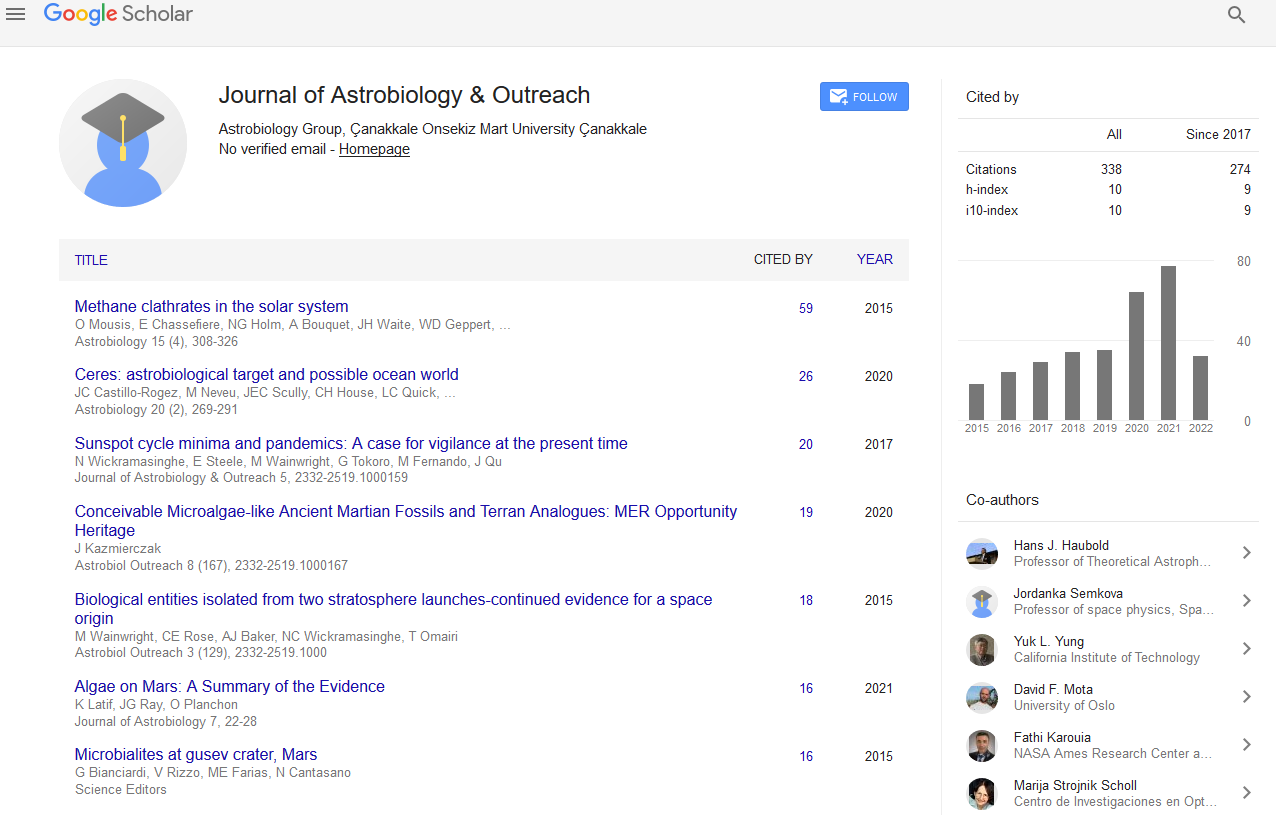Indexed In
- Open J Gate
- Academic Keys
- JournalTOCs
- RefSeek
- Hamdard University
- EBSCO A-Z
- OCLC- WorldCat
- Google Scholar
Useful Links
Share This Page
Journal Flyer

Open Access Journals
- Agri and Aquaculture
- Biochemistry
- Bioinformatics & Systems Biology
- Business & Management
- Chemistry
- Clinical Sciences
- Engineering
- Food & Nutrition
- General Science
- Genetics & Molecular Biology
- Immunology & Microbiology
- Medical Sciences
- Neuroscience & Psychology
- Nursing & Health Care
- Pharmaceutical Sciences
Commentary - (2023) Volume 11, Issue 5
Refining Celestial Choreography: Data Contributions to Collisionless Shock Models
Hiroshi Naraoka*Received: 22-Aug-2023, Manuscript No. JAO-23-24785; Editor assigned: 25-Aug-2023, Pre QC No. JAO-23-24785(PQ); Reviewed: 08-Sep-2023, QC No. JAO-23-24785; Revised: 15-Sep-2023, Manuscript No. JAO-23-24785(R); Published: 25-Sep-2023, DOI: 10.35248/2332-2519.23.11.319
Description
In the vast expanse of our solar system, where the solar wind stretches its invisible tendrils across space, collisionless shocks emerge as dynamic phenomena that shape the very fabric of the heliosphere. These cosmic ripples, generated by the interaction between the solar wind and various obstacles in space, provide scientists with a unique window into the complex of charged particles and magnetic fields that govern our celestial neighborhood.
A collisionless shock is a phenomenon that occurs when the solar wind, a continuous flow of charged particles streaming from the Sun, encounters obstacles in space. Unlike collisions in a dense medium, where particles interact frequently, collisionless shocks involve the interaction of particles through electromagnetic fields. The solar wind, composed primarily of protons and electrons, carries with it magnetic fields that play a pivotal role in the formation and dynamics of these shocks.
The heliosphere, a vast region dominated by the influence of the Sun, extends far beyond the orbit of Pluto. As the solar wind travels through space, it encounters various obstacles, such as planetary magnetospheres, interplanetary dust, and the remnants of previous solar eruptions. The interaction between the solar wind and these obstacles gives rise to collisionless shocks.
One common scenario is the interaction between the solar wind and the Earth's magnetosphere. As the solar wind flows around the Earth's magnetic field, it creates a bow shock on the sunward side. This bow shock serves as a prime example of a collisionless shock, where particles undergo acceleration and heating as they traverse the shock front.
Collisionless shocks exhibit unique characteristics that distinguish them from shocks in denser, collision-dominated environments. One key feature is the formation of electromagnetic waves, such as ion cyclotron and whistler waves, within the shock region. These waves play an important role in the acceleration of charged particles and the transfer of energy across the shock front.
Another notable aspect is the efficient acceleration of particles to high energies within collisionless shocks. Electrons and ions gain significant kinetic energy as they are propelled by the electric and magnetic fields generated during the shock process. The study of these accelerated particles provides insights into the mechanisms responsible for energizing particles in the heliosphere.
Collisionless shocks play a vital role in regulating the dynamics of the solar wind as it flows through the heliosphere. The interaction with obstacles creates turbulent regions, influencing the distribution of magnetic fields and charged particles. These shock-induced disturbances contribute to the variability observed in the solar wind, affecting space weather and the conditions experienced by spacecraft and planetary bodies in the solar system.
The study of collisionless shocks extends beyond the interplanetary medium and holds relevance for understanding the interaction between the solar wind and planetary bodies. Each planet with an intrinsic magnetic field, such as Earth, possesses a magnetosphere that modulates the solar wind's impact. The bow shocks formed around these magnetospheres offer insights into the planetary-scale processes influenced by collisionless shocks.
One of the significant consequences of collisionless shocks is the acceleration of charged particles to high energies. This acceleration process contributes to the generation of energetic particles, including Solar Energetic Particles (SEPs) and Galactic Cosmic Rays (GCRs). Understanding the mechanisms behind particle acceleration in collisionless shocks is important for predicting and mitigating the impact of space weather events on technological systems, including satellites and communication networks.
Studying collisionless shocks in the heliosphere requires advanced observational techniques and spacecraft instruments. Space missions, such as NASA's Parker Solar Probe and the European Space Agency's Solar Orbiter, are equipped with instruments designed to measure the properties of the solar wind and capture direct observations of collisionless shocks. These missions provide valuable data to improve our understanding of shock physics and the underlying processes at work in the heliosphere.
While advances in space missions and instrumentation have expanded our knowledge of collisionless shocks, significant challenges persist. The highly dynamic and complex nature of these shocks requires sophisticated modeling and theoretical frameworks to interpret observational data accurately. Additionally, the vast distances involved and the need for precise measurements pose logistical challenges in capturing in-situ observations of collisionless shocks.
As our exploration of the heliosphere continues, collisionless shocks remain a focal point of research, provide a foundation to understanding fundamental processes in space physics. The data collected from ongoing and upcoming space missions will contribute to refining our models and theories, focus on the interconnected dynamics of the solar wind, magnetic fields, and charged particles.
In conclusion, collisionless shocks in the heliosphere represent a interesting region of astrophysical phenomena that influence the dynamics of our solar system. From the formation of bow shocks around planets to the acceleration of energetic particles, these cosmic ripples expose the intricate interplay of forces shaping our celestial neighborhood. As scientists delve deeper into the unexplainable of collisionless shocks, they uncover valuable insights into the fundamental processes that govern space weather, particle acceleration, and the dynamic equilibrium of the heliosphere.
Citation: Naraoka H (2023) Refining Celestial Choreography: Data Contributions to Collisionless Shock Models. J Astrobiol Outreach. 11:319.
Copyright: © 2023 Naraoka H. This is an open-access article distributed under the terms of the Creative Commons Attribution License, which permits unrestricted use, distribution, and reproduction in any medium, provided the original author and source are credited.

